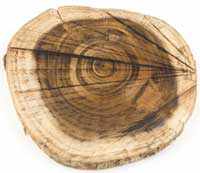Sapwood and Heartwood – What Are The Differences
The enthralling world of woodworking hides secrets deep within the tree’s rings, revealing a mystical journey from the vibrant sapwood to the sturdy heartwood.
Understanding the nuanced distinctions between these two essential wood components isn’t merely informational; it’s transformative for any woodworking project.
Whether you’re a seasoned craftsman or embarking on your first project, uncover the hidden tales that sapwood and heartwood tell, navigating through their characteristic differences and gaining insights that promise to elevate the quality and longevity of your creations.
Let’s journey together into the tree’s heart, exploring the vitality of sapwood and the robust elegance of heartwood, and unveiling how this knowledge can be your unseen ally in crafting wood masterpieces.

- The Parts of a Tree
- What is Sapwood
- What is Heartwood
- Sapwood and Heartwood Moisture Content
- What are the Importances of Sapwood and Heartwood
- How to Keep Sapwood and Heartwood from Damages?
To achieve high-quality woodworking, knowledge about wood is a must. Projects can succeed or fail based on which part of a tree is used. In particular, it’s important to know the difference between heartwood and sapwood.
The Parts of a Tree
Knowing how a tree grows sheds light on which part of a tree is best for your woodworking project. A tree trunk is composed of the following basic parts, listed in order beginning with the outer layer:
- The bark is dead tissue; and its function is to protect the tree from weather, insects, disease, fire, and injury.
- The phloem is a thin layer comprised of living cells, and its basic function is to transport food around the tree.
- The cambium is living tissue. This very thin layer of a tree produces both new phloem on one side and new xylem on the other.
- The largest part of a trunk is the xylem, which is composed of both sapwood and heartwood.
What is Sapwood
Sapwood is new wood and is like a pipeline that moves water through the tree up to the leaves. Essentially the working component of a tree, sapwood transports water and sap similar to the way blood flows through our veins, capillaries, and arteries.
You can usually spot the difference between the two distinct parts of the tree’s xylem if you were to view a crosscut of a mature hardwood tree’s trunk. Once you remove the comparatively thin outer layers, the tree is essentially made up of sapwood, which is lighter colored wood, and heartwood, which is darker in color.
Lumber cut from sapwood shrinks considerably as it goes through the drying process. This part of a tree is also far more susceptible to fungus than the center of the trunk.

The darker, inner wood is heartwood. The outer, lighter portion is sapwood.
What is Heartwood
The central, strong pillar of a tree is heartwood. As new rings of sapwood grow, the inner cells are put out of commission and become heartwood. Although this portion of the tree is dead or retired sapwood, it doesn’t decay. As long as the tree’s outer layers are intact, heartwood remains strong.
What occurs as moisture is no longer transported through the straw-like cells, the pores in Heartwood are filled with organic material. The presence of chemicals called extractives causes the cell walls in heartwood to change color. Extractives are what create the rich color and unique character in the heartwood.
The functional beauty of heartwood for a woodworker is threefold. First, it’s significantly less susceptible to fungus. Secondly, heartwood contains far less moisture than sapwood and will have far less shrinkage when it’s dried. Thirdly, heartwood becomes in some ways as strong as steel as the fibers are bound together.
What are the Importances of Sapwood and Heartwood
While both sapwood and heartwood originate from the same tree, their roles, especially within the realm of woodworking, are distinctively divergent, yet symbiotically intertwined.
Importance of Sapwood
- Life Sustainer: Sapwood plays a pivotal role in a tree’s life, acting as a conduit for water and essential nutrients from the roots to the leaves, sustaining the tree’s life processes.
- Elasticity and Flexibility: Often being younger wood, sapwood tends to be more elastic and is typically used in applications where flexibility is crucial, such as in the manufacturing of plywood.
- Lighter Hue: The lighter color of sapwood offers a unique aesthetic, providing woodworkers with varied color options within a single piece of lumber.
Importance of Heartwood
- Strength and Durability: Heartwood, often denser and harder than sapwood, provides a robust core that supports the tree and is sought after in woodworking for its structural strength.
- Resistance: Its natural resistance to decay and insects makes heartwood especially valuable for projects requiring longevity and durability, such as outdoor furniture or structural elements.
- Rich Color: The darker, often richer color of heartwood is favored for its aesthetic appeal and is utilized to impart a premium, elegant look to finished woodworking projects.
How to Keep Sapwood and Heartwood from Damages?
The preservation of both sapwood and heartwood is paramount to maintaining their inherent beauty and structural integrity, ensuring they continue to shine in your woodworking endeavors.
Protecting Sapwood
- Fungus Prevention: Due to its susceptibility to fungal attack, ensure that sapwood is treated with anti-fungal agents or is adequately kiln-dried.
- Moisture Control: Employ moisture meters to monitor the sapwood’s moisture content, keeping it within an optimal range to prevent warping or cracking.
- Safe Storage: Store sapwood in a controlled environment, away from excessive moisture and direct sunlight, to maintain its quality and color.
Safeguarding Heartwood
- Sealants Use: Apply sealants to heartwood to preserve its rich color and protect it from potential staining or weather-induced damage.
- Anti-Insect Treatment: While naturally resistant, treating heartwood with additional insect repellents ensures a fortified defense against potential pest attacks.
- Adapted Use: Be mindful of heartwood’s characteristics and ensure its use aligns with its properties, such as leveraging its strength and durability in structural applications.
Every piece of lumber, whether sapwood or heartwood, narrates a unique story from the heart of nature.
By understanding and respecting their roles and properties, and ensuring diligent care, we can weave these stories into our creations, crafting pieces that stand the test of time and pay homage to the magnificent entities from which they originated.

Free Download – 6 Reasons Your Wood Project Failed
Sapwood and Heartwood Moisture Content
Regardless of whether the woodworker is working with sapwood or heartwood, the correct moisture content of the wood is critical to meet the demands for the end use of the product being made. A high-quality, accurate moisture meter is, therefore, a must for the serious woodworker.
Both heartwood and sapwood hold moisture. Before drying, heartwood holds far less moisture than sapwood1, but you need to account for the moisture content (MC) in both types of wood. If the MC percentage is too low or high, your work could be damaged as the wood shrinks or expands in the process of equilibrating with its surroundings.
In most cases, you want the wood to reach an MC between 6% to 8% before you start working with it. That’s the suitable MC for most indoor spaces with the HVAC operating. A pinless moisture meter will deliver fast and accurate MC readings without damaging the wood. Take multiple readings across the wood to get the most complete picture of the wood’s MC before you start working with it.
The nuances between sapwood and heartwood stretch beyond their visual distinctions, seeping into the essence of their functional properties in woodworking.
By embracing this knowledge and marrying it with skilled craftsmanship, you pay homage to the majesty of the trees and elevate your woodworking projects to realms of enhanced durability and aesthetic appeal. It’s not merely about crafting; it’s about understanding and respecting the wood, ensuring each piece reflects the highest quality and care.
Ensure your projects stand the test of time by never underestimating the importance of managing wood moisture content.
Dive deeper into crafting perfection with Wagner Meters, your reliable partner in delivering accurate moisture measurements safeguarding your projects against unforeseen moisture-related pitfalls.
Elevate your woodworking journey, safeguard your creations, and immortalize your craftsmanship with the precision and reliability of Wagner Meters. Let every ring in the wood echo the tales of quality, durability, and masterful woodworking.
As Sales Manager for Wagner Meters, Ron has more than 35 years of experience with instrumentation and measurement systems in different industries. In previous positions, he has served as Regional Sales Manager, Product and Projects Manager, and Sales Manager for manufacturers involved in measurement instrumentation.
Last updated on December 12th, 2024




who long durable of neem sapwood?
Zakir, the species name of Neem is another name for Indian Lilac, I believe. We have no information in the sapwood durability of this species, but I recommend you contact the Indian Forest Service to attempt to acquire the information you need.
Here is a link to their website: http://ifs.nic.in